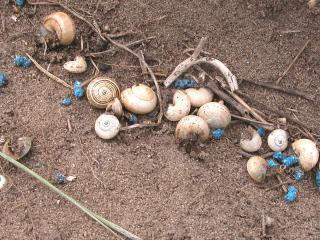Chemical control
Baits
Slugs and snails can only be controlled by baits if they are mobile and looking for food. Note that young snails ie those less than 7mm in diameter for round snails and 7mm in height for conical snails are not likely to be controlled by baits. Young snails feed on decaying plant matter and are not likely to be attracted to baits.
Snail and slug numbers should be monitored to determine if there is a need to bait especially during crop emergence. Baiting will generally only kill 50% of a slug population at any one time and then mainly the larger ones. Younger slugs may emerge in successive waves. Monitoring numbers (refer to Table 1) will determine if there is a need for multiple bait applications. Based on this, baiting can be confined to areas of high snail/slug density.
All baiting must be stopped at least two months prior to harvest to ensure baits are broken down and do not become a contaminant of grain.
When to bait
The best time to apply pellets is early in the season when morning temperatures are low and dew forms, and after the first good germinating rains - this is when slugs and snails begin emerging and are looking for food. Killing mature slugs and snails before autumn egg laying reduces the potential population build up for that season.
Late bait applications are less effective as there is a lot of green material that provides an alternative food source.
Non-rainfast pellets may become covered by soil during rain and decay after wetting. Consider reapplying baits after heavy rain.
Bait rates
Baiting with multiple applications at the lowest registered rate rather than a single application of a high rate is best as the pellets lose their effectiveness after a few nights.
Consider increasing baits up to the highest registered rate if there are more than 80 snails (either round or conical) and 10 or more slugs per m2.
Even bait coverage increases the likelihood of slugs or snails encountering the bait and feeding on the bait. Trials suggest 30 baits per square metre give good control.
There are many bait types on the market. These vary in their spreadability and cost. See 'Snail and slug baiting guidelines' in the link section.
Fence line and border baitings
Snails, especially, aestivate on fence posts and road side vegetation, while slugs may aestivate under road side vegetation. In autumn, when snails and slugs are active, these areas may have a high level of activity. Repeated baitings in these areas can lead to high pest mortality. If snail and slug pressures are high consider baiting at higher rates.
Sprays
There are no sprays registered for snail and slug control in broadacre cropping. Be aware that insecticides commonly used to control insect pests of broadacre crops are not effective against slugs and snails.

